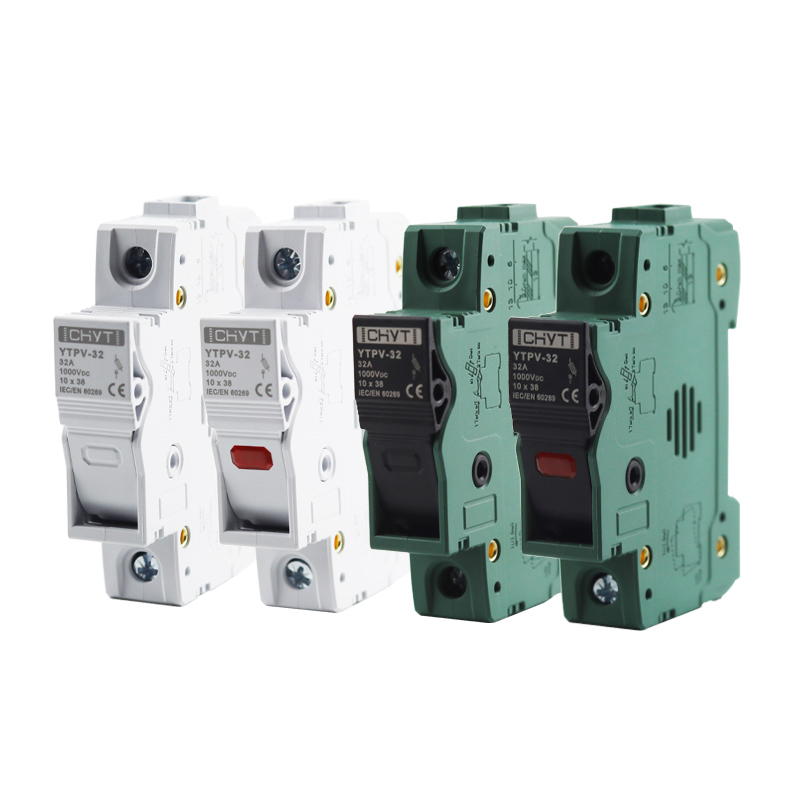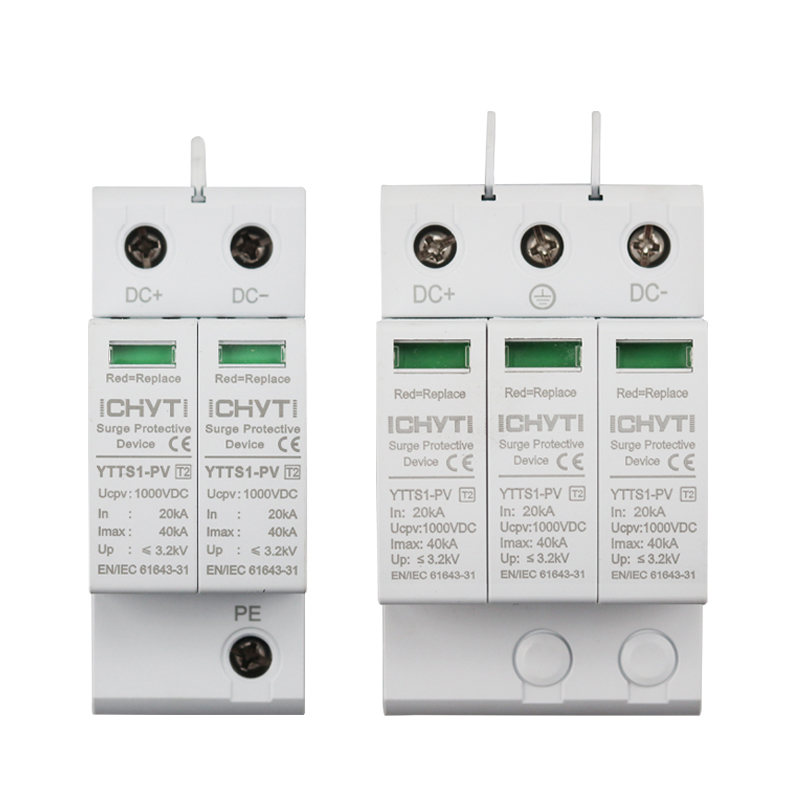
- English
- Español
- Português
- русский
- Français
- 日本語
- Deutsch
- tiếng Việt
- Italiano
- Nederlands
- ภาษาไทย
- Polski
- 한국어
- Svenska
- magyar
- Malay
- বাংলা ভাষার
- Dansk
- Suomi
- हिन्दी
- Pilipino
- Türkçe
- Gaeilge
- العربية
- Indonesia
- Norsk
- تمل
- český
- ελληνικά
- український
- Javanese
- فارسی
- தமிழ்
- తెలుగు
- नेपाली
- Burmese
- български
- ລາວ
- Latine
- Қазақша
- Euskal
- Azərbaycan
- Slovenský jazyk
- Македонски
- Lietuvos
- Eesti Keel
- Română
- Slovenski
- मराठी
- Srpski језик
Selection and Design of Safety Devices in Photovoltaic Systems
2023-07-10
Power stations are generally installed in the wilderness, or on the roof, and the components must be installed in the open air. The natural environment is harsh, and natural and man-made disasters are inevitable. Natural disasters such as typhoons, snowstorms, and sand and dust will damage the equipment. The safety of the power station is very important. Whether it is a distributed small power station or a centralized large-scale ground power station, there are certain risks. Therefore, the equipment must be equipped with special safety devices, such as fuses and lightning protection devices. , Always safeguard the safety of the power station.
1. Fuse
CHYT fuse is a current protector made according to the principle of breaking the circuit by melting the melt with the heat generated by itself after the current exceeds the specified value for a certain period of time. Fuses are widely used in low-voltage power distribution systems, control systems, and electrical equipment. As short-circuit and over-current protection, fuses are one of the most commonly used protection devices. The fuses of photovoltaic power plants are divided into DC fuses and AC fuses.
The DC side of the photovoltaic power station connects multiple strings in parallel to the DC bus bar of the DC combiner box (centralized scheme) or the string inverter (string inverter scheme) according to the configuration of the scheme. When several photovoltaic strings are connected in parallel, if a short-circuit fault occurs in a certain string, the other strings on the DC bus and the grid will provide short-circuit current to the short-circuit point. If the corresponding protective measures are lacking, it will lead to burning of equipment such as cables connected to it. At the same time, it may cause burning of attachments near the equipment. At present, there are many similar roof photovoltaic fire accidents in China, so it is necessary to install protective devices in the parallel circuits of each string to enhance the safety of photovoltaic power plants.

At present, DC fuses are used in combiner boxes and inverters for overcurrent protection. Mainstream inverter manufacturers also regard fuses as the basic components of DC protection. At the same time, fuse manufacturers such as Bussman and Littelfuse have also launched photovoltaic-specific DC fuses.
With the increasing demand for DC fuses in the photovoltaic industry, how to correctly select DC fuses for effective protection is a problem that both users and manufacturers should pay close attention to. When selecting DC fuses, you cannot simply copy AC fuses. Electrical specifications and structural dimensions, because there are many different technical specifications and design concepts between the two, are related to the comprehensive consideration of whether the fault current can be broken safely and reliably without accidents.
1) Since the DC current has no current zero-crossing point, when breaking the fault current, the arc can only be extinguished rapidly by itself under the action of the forced cooling of the quartz sand filler, which is much more difficult than breaking the AC arc. The reasonable design and welding method of the chip, the purity and particle size ratio of the quartz sand, the melting point, the curing method and other factors all determine the efficiency and effect on the forced extinguishing of the DC arc.
2) Under the same rated voltage, the arcing energy generated by the DC arc is more than twice that of the AC arcing energy. In order to ensure that each section of the arc can be limited within a controllable distance and quickly extinguished at the same time, no section will appear The arc is directly connected in series to cause a huge energy pool, resulting in an accident that the fuse bursts due to the continuous arcing time is too long. The tube body of the DC fuse is generally longer than the AC fuse, otherwise the size cannot be seen in normal use. The difference, when the fault current occurs, will have serious consequences.
3) According to the recommended data of the International Fuse Technology Organization, the length of the fuse body should be increased by 10mm for every 150V DC voltage increase, and so on. When the DC voltage is 1000V, the body length should be 70mm.
4) When the fuse is used in the DC circuit, the complex influence of the inductance and capacitance energy must be considered. Therefore, the time constant L/R is an important parameter that cannot be ignored. It should be determined according to the occurrence and decay rate of the short-circuit fault current of the specific line system. Accurate evaluation does not mean that you can choose a major or a minor at will. Since the time constant L/R of the DC fuse determines the breaking arc energy, breaking time and let-through voltage, the thickness and length of the tube body must be selected reasonably and safely.
AC fuse: At the output end of the off-grid inverter or the input end of the internal power supply of the centralized inverter, an AC fuse should be designed and installed to prevent the load from overcurrent or short circuit.
2. Lightning protector
The main part of the photovoltaic system is installed in the open air, and the distribution area is relatively large. The components and supports are conductors, which are quite attractive to lightning, so there is a danger of direct and indirect lightning strikes. At the same time, the system is directly connected to related electrical equipment and buildings, so lightning strikes to the photovoltaic system will also involve related equipment, buildings and electrical loads. In order to avoid lightning damage to the photovoltaic power generation system, it is necessary to set up a lightning protection and grounding system for protection.
Lightning is an electrical discharge phenomenon in the atmosphere. During the formation of cloud and rain, some parts of it accumulate positive charges, and the other part accumulates negative charges. When these charges accumulate to a certain extent, a discharge phenomenon will occur, forming lightning. Lightning is divided into direct lightning and induction lightning. Direct lightning strikes refer to lightning strikes that directly fall on photovoltaic arrays, DC power distribution systems, electrical equipment and their wiring, as well as nearby areas. There are two ways of intrusion of direct lightning strikes: one is the above-mentioned direct discharge of photovoltaic arrays, etc., so that most of the high-energy lightning current is introduced into buildings or equipment, lines; the other is that lightning can directly pass through lightning rods, etc. The device that transmits the lightning current into the ground discharges, causing the ground potential to rise instantaneously, and a large part of the lightning current is reversely connected to the equipment and lines through the protective grounding wire.

Inductive lightning refers to lightning strikes generated near and farther away from related buildings, equipment and lines, causing overvoltage of related buildings, equipment and lines. This surge overvoltage is connected in series through electrostatic induction or electromagnetic induction. to related electronic equipment and lines, causing harm to equipment and lines.
For large-scale or photovoltaic power generation systems installed in open fields and high mountains, especially in lightning-prone areas, lightning protection grounding devices must be equipped.
Surge protection device (Surge protection Device) is an indispensable device in the lightning protection of electronic equipment. It used to be called "lightning arrester" or "overvoltage protector". The English abbreviation is SPD. The function of the surge protector is to limit the instantaneous overvoltage that enters the power line and signal transmission line within the voltage range that the equipment or system can withstand, or to leak the powerful lightning current into the ground, so as to protect the protected equipment or system from being damaged. Damaged by impact. The following is a description of the main technical parameters of arresters commonly used in photovoltaic power generation systems.
(1) Maximum continuous operating voltage Ucpv: This voltage value indicates the maximum voltage that can be applied across the arrester. Under this voltage, the arrester must be able to work normally without failure. At the same time, the voltage is continuously loaded on the arrester without changing the working characteristics of the arrester.
(2) Rated discharge current (In): It is also called the nominal discharge current, which refers to the current peak value of the 8/20μs lightning current waveform that the arrester can withstand.
(3) Maximum discharge current Imax: When a standard lightning wave with a waveform of 8/20ms is applied to the protector once, the maximum peak value of the shock current that the protector can withstand.
(4) Voltage protection level Up(In): The maximum value of the protector in the following tests: the flashover voltage with a slope of 1KV/ms; the residual voltage of the rated discharge current.
The surge protector uses a varistor with excellent nonlinear characteristics. Under normal circumstances, the surge protector is in a state of extremely high resistance, and the leakage current is almost zero, ensuring the normal power supply of the power system. When an overvoltage occurs in the power system, the surge protector will be turned on immediately within nanoseconds to limit the magnitude of the overvoltage within the safe working range of the equipment. At the same time, the energy of the overvoltage is released. Subsequently, the protector quickly changes to a high-impedance state, thus not affecting the normal power supply of the power system.
In addition to lightning can generate surge voltage and current, it will also occur at the moment of closing and disconnecting of high-power circuit, the moment of turning on or off of inductive load and capacitive load, and the disconnection of large power system or transformer. Large switching surge voltage and current will also cause harm to related equipment and lines. In order to prevent lightning induction, a varistor is added to the DC input end of the low-power inverter. The maximum discharge current can reach 10kVA, which can basically meet the needs of household photovoltaic lightning protection systems.



